The very concept of 'seeking a balance' in the northern Flinders implies that some sort of an 'all else being equal' state might prevail between conservation and mining elsewhere in the state - and this is so far from being the case that the notion is rendered absurd! In South Australia, conservation is on a hiding to nothing where it confronts the mining industry!
Take, for instance, Map 1 below -

Here's the whole of the state, showing those areas that are actually excluded from mining industry access. The fully-protected, no mining access 'single proclamation' reserves - that's the Wilderness Protection Areas and some National and Conservation Parks - are marked in 2 shades of dark green, and the 'Areas excluded from the Mining Act' - such as the Leigh Creek Coalfield and the City of Adelaide - are marked in red. (Click the image to go to the Flickr site for larger versions of each image and considerably more detail)
Otherwise the remainder of the area of the state is available to the mining and petroleum industry.
You might be about to be surprised, if not shocked. What follows is a map which contains the same details shown in the first map, with the addition of the mining-industry accessible. 'joint proclamation' Reserves - that's the remainder of the National and Conservation Parks, and the Regional Reserves -
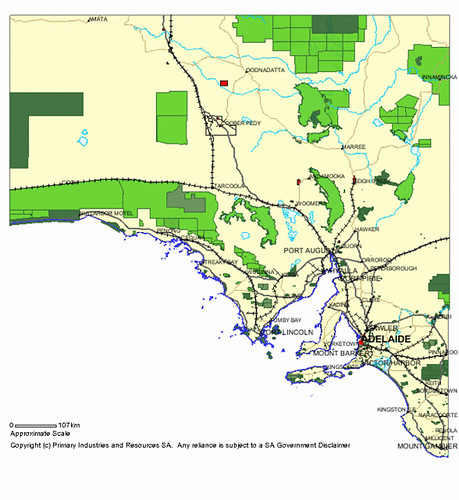
That's right, more than 3/4 of the land area of the reserve system of South Australia is open to the mining industry! All Reserves constitute a little over 20% of the state by area, so if 3/4 of these are mineable, and the remaining 'Areas excluded from the Mining Act' are not large - as can clearly be seen - what follows is that the mining industry has access to more than 90% of the state!
Now, in the 'joint-proclamation' parks access is 'restricted', and there are other restrictions placed on the mining and petroleum industries when dealing with, say, Aboriginal Land and the Woomera Prohibited Area. The industry may well attempt to point to this - in fact, some wring their hands and claim to be tragically inhibited in showering us with the benefits they are doubtlessly only-too-keen to bestow upon us; but let's just have a look at the extent to which their style is actually being cramped, shall we?
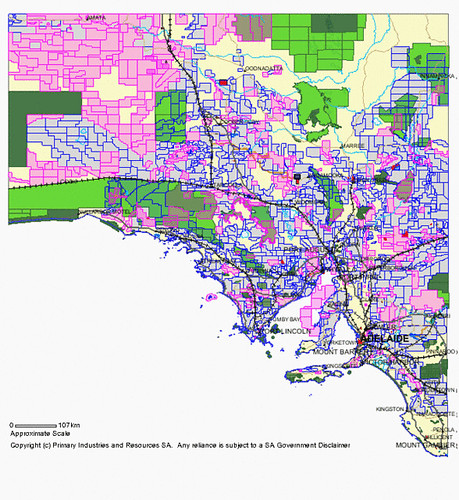
Whoah! - bright, isn't it? We've now added the Mineral Leases - that's the Mineral Exploration Leases in blue, and the Mineral Exploration Lease Applications in pink. There are production tenements as well, but they're hard to see at this scale. (A reminder, click each image to see a lot more detail on Flickr)
What you can pick out at this scale is that the Gawler Ranges National Park and the northern section of the adjacent Pinkawillinie Conservation Park, Tallaringa Conservation Park, Lakes Gairdner, Torrens, and Frome, and the Yellabinna, Strzelecki and Innamincka Regional Reserves have now largely been subsumed. Oh, and the Witjira National Park on the northern border is entirely covered.
Did you know Mount Remarkable National Park is largely open to the mining industry, by the way? I thought not.
But that's not the whole story - we haven't looked at the petroleum industry yet! -

Well, isn't that enough to warm a shareholder's heart? Goodbye Simpson Desert Regional Reserve and the remainder of the Innamincka RR. Petroleum Exploration Leases, Exploration Lease Applications, Production Tenements... it certainly makes for a colourful show! If you want the complete details I've included a copy of the Legend as part of this set of images on Flickr.
(You can also go there to scroll through any of these images at a larger scale - Seeking a Balance - the Missing Maps [I recommend the slideshow option - button upper right] - and also to get a foretaste of my next posting, which will deal specifically with the Flinders Ranges and the area surrounding the Arkaroola Wilderness Sanctuary - the target of Seeking a Balance.
However, my point is simple. There is no balance between the mining industry and conservation is South Australia. The industry is winning hands-down.
The state government cannot selectively pick a section of the northern Flinders Ranges - one of the few remaining semi-arid mountain ecosystems in Australia in good (and up to excellent) condition at that! - and claim to play an 'even handed' game, as though the industry didn't already have the run of the state. As though such fragile and complex mountain ecosystems weren't the exception rather than the rule in the broad, flat inlands of South Australia. And as if they were well preserved elsewhere and weren't embattled enough already (goats, climate change etc.) This is not just absurd, it's offensive!
NEXT POST - Applying the same focus to the Flinders Ranges.
All these maps were taken from Primary Industries and Resources SA's excellent South Australian Resource information Geoserver. (Ironically, I may be SARIG's biggest fan!)
Images © PIRSA SARIG geoserver 2010 - https://egate.pir.sa.gov.au/geoserver/sarig/frameSet.jsp

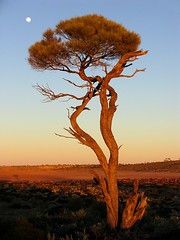

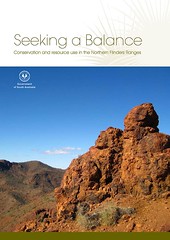
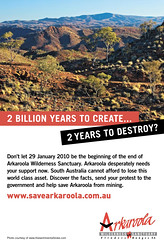
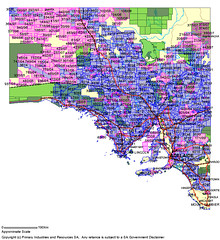
![link to the u[n]sa homepage](http://users.chariot.net.au/~greenh/blog/unknownsa_ublog-text.gif)


![link to the u[n]sa features page](http://users.chariot.net.au/~greenh/blog/features_ublog-text.gif)
![link to the u[n]sa kangaroo island feature image pages](http://farm2.static.flickr.com/1306/1187313059_93fdefd86b_o.jpg)
![link to the u[n]sa katarapko creek / murray river np feature image pages](http://farm2.static.flickr.com/1435/1181073355_b5c45f799d_o.jpg)


!['constellation' - wild country [national] set on flickr](http://farm1.static.flickr.com/155/415123844_3e6da621e5_s.jpg)

!['the bay serene' - the wild west [coast] set on flickr](http://farm1.static.flickr.com/121/312226516_606ac35455_s.jpg)








![u[n]sa journal -thanks for your time! u[n]sa journal - thanks for your time!](http://users.chariot.net.au/~greenh/blog/journal_ublog-text.gif)
I would like to say that this is typical of a state in search of an economy: SA and mining; TAS and Gunn's mowing down forests. However, more well healed states are into this sort of thing too. Does Australia have the best governments that money can buy?
ReplyDeleteBill,
ReplyDeleteThankyou very much for this post. I am involved with the same issue of mining on conservation land in Queensland, and it is extremely concerning given the precious few 'intact' places remaining in Australia. I will keep an eye on your blog entries and wish you all the best in your important work.
Sonya (see www.bimblebox.org if interested)
My family and I have travelled many times to the Flinders and S.A.in general. Frankly we are not surprised by the attitude of the Miners and Gov's in general.
ReplyDeleteThe miners are money hungry at all costs life forms (We are not Greenies, extremists of any such thing.....we are a family who appreciate what nature has given us...we are not religious either). The Politians on the other hand are cowards not to stand up to these corporations because of the lost taxes and revenue they expect to get from the mines.
We have some of the most beautiful lands on this planet, and some body wants to put a hole in it... what a disgrase. Because it is remote and doesn't contain high rise buildings, condo's, realestate agents on every corner and no views to the shopping centres and the sea it is considered useless land, barren land and uninteresting land. On the contrary it could not be more beautiful.... partly because it does not have those things. It is a place that hasn't been touched (too much) by the ugly hand of man. It provides a feeling of history. I have read some of the texts about the early days, and it easy (fairly) to imagine what it was like when this country was being opened up to exploration. But not like the "exploration" going on today and tomorrow. They did not deface the land on such a scale. Bless the Australian outback, it is our history. Regards
Peter Saunders (melb. Vic)